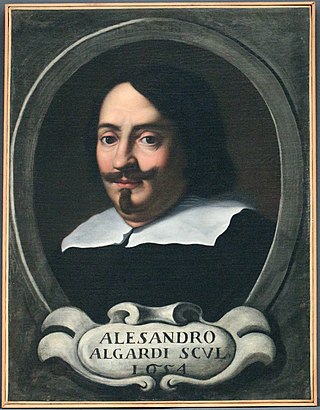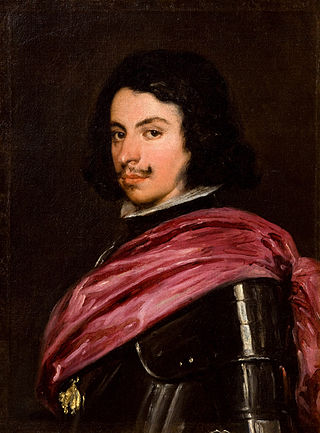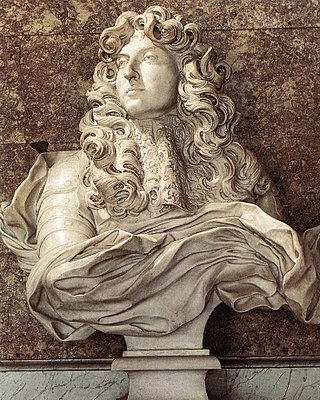
Alessandro Algardi was an Italian high-Baroque sculptor active almost exclusively in Rome. In the latter decades of his life, he was, along with Francesco Borromini and Pietro da Cortona, one of the major rivals of Gian Lorenzo Bernini, in Rome. He is now most admired for his portrait busts that have great vivacity and dignity.

Gian LorenzoBernini was an Italian sculptor and architect. While a major figure in the world of architecture, he was more prominently the leading sculptor of his age, credited with creating the Baroque style of sculpture. As one scholar has commented, "What Shakespeare is to drama, Bernini may be to sculpture: the first pan-European sculptor whose name is instantaneously identifiable with a particular manner and vision, and whose influence was inordinately powerful ..." In addition, he was a painter and a man of the theatre: he wrote, directed and acted in plays, for which he designed stage sets and theatrical machinery. He produced designs as well for a wide variety of decorative art objects including lamps, tables, mirrors, and even coaches.

The Galleria Borghese is an art gallery in Rome, Italy, housed in the former Villa Borghese Pinciana. At the outset, the gallery building was integrated with its gardens, but nowadays the Villa Borghese gardens are considered a separate tourist attraction. The Galleria Borghese houses a substantial part of the Borghese Collection of paintings, sculpture and antiquities, begun by Cardinal Scipione Borghese, the nephew of Pope Paul V. The building was constructed by the architect Flaminio Ponzio, developing sketches by Scipione Borghese himself, who used it as a villa suburbana, a country villa at the edge of Rome.

The life-size ancient but much restored marble statue known as the Barberini Faun, Fauno Barberini or Drunken Satyr is now in the Glyptothek in Munich, Germany. A faun is the Roman equivalent of a Greek satyr. In Greek mythology, satyrs were human-like male woodland spirits with several animal features, often a goat-like tail, hooves, ears, or horns. Satyrs attended Dionysus.

The Palazzo Barberini is a 17th-century palace in Rome, facing the Piazza Barberini in Rione Trevi. Today, it houses the Galleria Nazionale d'Arte Antica, the main national collection of older paintings in Rome.

The Borghese Collection is a collection of Roman sculptures, old masters and modern art collected by the Roman Borghese family, especially Cardinal Scipione Borghese, from the 17th century on. It includes major collections of Caravaggio, Raphael, and Titian, and of ancient Roman art. Cardinal Scipione Borghese also bought widely from leading painters and sculptors of his time, and Scipione Borghese's commissions include two portrait busts by Gian Lorenzo Bernini. Most of the collection remains intact and on display at the Galleria Borghese, although a significant sale of classical sculpture was made under duress to the Louvre in 1807.

Blessed Ludovica Albertoni is a funerary monument by the Italian Baroque artist Gian Lorenzo Bernini. The Trastevere sculpture is located in the specially designed Altieri Chapel in the Church of San Francesco a Ripa in Rome, Italy. Bernini started the project in 1671, but his work on two other major works—The Tomb of Pope Alexander VII and the Altar of the Blessed Sacrament in St. Peter's Basilica—delayed his work on the funerary monument. Bernini completed the sculpture in 1674; it was installed by 31 August 1674.

Francesco I d'Este was Duke of Modena and Reggio from 1629 until his death. The eldest son of Alfonso III d'Este, he became reigning duke after his father's abdication.

The Bust of Louis XIV is a marble portrait by the Italian artist Gian Lorenzo Bernini. It was created in the year 1665 during Bernini's visit to Paris. This sculptural portrait of Louis XIV of France has been called the "grandest piece of portraiture of the Baroque age". The bust is on display at the Versailles Palace, in the Salon de Diane in the King's Grand Apartment.

Two Busts of Cardinal Scipione Borghese are marble portrait sculptures executed by the Italian artist Gian Lorenzo Bernini in 1632. Cardinal Scipione Borghese was the nephew of Pope Paul V, and had commissioned other works from Bernini in the 1620s. Both versions of this portrait are in the Galleria Borghese, Rome.

The Bust of Francesco I d'Este is a marble portrait bust by the Italian sculptor Gian Lorenzo Bernini. Completed in 1652, the work depicts Francesco I d'Este, Duke of Modena. It is in the Galleria Estense, Modena, Italy. The noble yet detached expression of the face, the extensive drapery and the lavish locks of hair are often taken to be emblematic of the way Bernini represented "absolute monarchs" as seemingly adopting superior poses, oblivious to their surroundings. A painting of the portrait bust, surrounded by various objects, undertaken by the artist Francesco Stringa in the late 1660s is in the Minneapolis Institute of Art.

The Bust of Camilla Barbadoni is a marble sculpture by the Italian artist Gian Lorenzo Bernini. Executed in 1619, it portrays the (deceased) mother of the Maffeo Barberini. Camilla had died in 1609. Barberini would become Pope Urban VIII in 1623.

The Bust of Costanza Bonarelli is a marble statue bust created by Gian Lorenzo Bernini during the 1630's. The piece is currently being shown in the Museo Nazionale del Bargello in Florence, Italy. Considered among the most personal of Bernini's works, the bust shows a figure named Costanza Piccolomini Bonarelli, the wife of Matteo Bonarelli, and one of Bernini's disciples and colleagues.

The Statue of Pope Clement X is one of the final sculptural works executed by the Italian artist Gian Lorenzo Bernini. It depicts Pope Clement X in the act of benediction, and is housed in the Galleria Nazionale d'Arte Antica in the Palazzo Barberini, Rome.

The Equestrian Statue of King Louis XIV is a sculpture designed and partially executed by the Italian artist Gian Lorenzo Bernini, who was originally brought to France to design a new facade of the Louvre, a portrait bust, and an equestrian statue. Bernini first discussed the project while in France in the mid-1660s, but it did not start until later in the decade, when back in Rome. It was not completed until 1684 and then shipped to Paris in 1685. Louis XIV of France was extremely unhappy with the end result and had it placed in a corner of the gardens of the royal palace at Versailles. Soon after, the sculpture was modified by François Girardon and altered into an equestrian sculpture of the ancient Roman hero Marcus Curtius.

The Memorial to Alessandro Valtrini is a funerary monument designed by the Italian artist Gian Lorenzo Bernini in 1639, and executed by his workshop in the same year. It is situated in the church of the San Lorenzo in Damaso in Rome. It has strong affinities with the Memorial to Ippolito Merenda; both were undertaken by Bernini's workshop and commissioned by Cardinal Francesco Barberini to commend the ecclesiastical work done by Valtrini and Merenda respectively. In aesthetic terms, both broke new ground in figuring Death as a moving skeleton carrying a flowing inscriptions and, in the case of Alessandro Valrtrini monument, a medallion-shaped portrait of Valtrini himself.

Charles I in Three Positions, also known as the Triple Portrait of Charles I, is an oil painting of Charles I of England painted 1635–1636 by the Flemish artist Sir Anthony van Dyck, showing the king from three viewpoints: left full profile, face on, and right three-quarter profile. It is currently part of the Royal Collection.

The Triple Portrait of Cardinal de Richelieu is an oil-on-canvas painting by French artist Philippe de Champaigne, completed c. 1642. The portrait shows Cardinal de Richelieu from three angles: right profile, face on, and left profile. The painting was made as a study for a bust to be made by an Italian sculptor in Rome. It is now held by the National Gallery, London.
Boy with a Dragon is a c. 1617 white marble sculpture, now in the Getty Museum, which has owned it since 1987. It draws on the myth of the infant Hercules strangling serpents sent to kill him.

Portrait of Cardinal Pietro Bembo is a 1539–1540 oil on canvas painting of by Titian, now in the National Gallery of Art in Washington, D.C.



















